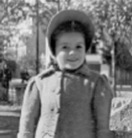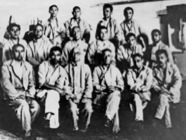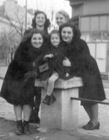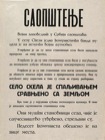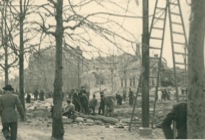Serbian Holocaust
Sofija Sonja Demajo Lunginović, February 11, 2010, Belgrade
Sofija Sonja Demajo Lunginović survived holocaust in Belgrade as a two year old Jewish orphan. After WWII she learned that her father was shot in German represals as a prisoner of Banjica camp, and her mother was killed in gas van with all of the prisoners of Semlin Judenlager in the spring of 1942. In a family of her mother’s friend, widowed Maria Andselić, she grew up surounded by unconditional love.
Interviewer: Matteo Bojanovich | Camera: Nemanja Krdžić | Editing: Nada Ljubić| Transcript: Nada Ljubić
![]()
![]()
English rendition of the interview, paraphrased and abridged:
Sofia Demajo: ... I remember the bombs, running, hiding in shelters, and in the basement, and in Belgrade New Cemetery ... All of this I remember very well, the sirens, the Messerschmitts [German airplanes], the bombs, the soup lines in Dusanova Street, near the “Elka” factory. Once, while the mothers stood waiting in the soup line, we children were playing among bushes. We were playing hide and seek, and I was hiding; the sirens came on, and I stayed hidden in the bushes. Suddenly, everything was silent. I waited, and then I came out; everyone was gone.
I found myself in the middle of Dusanova Street, and, like it was today, I remember a voice calling me, and those lovely Italian words: "Bambina! Bambina!" Well, in one building's entrance stood an Italian soldier, calling me, and he pulled me in. When the all-clear came, I said to him that I want to go home. I have no idea how we understood each other, but I know that he was holding my hand nicely and looking at me. I said to him that I can sing and I sang the song “Mama” for him... So, we walked down the street, he held my hand and I only knew that we should go straight ahead. So we came to the Alexander Nevsky Church, and there I said, "Now I know where my home is." Near Alexander Nevsky Church I turned left and there was my house gate.
And I said to him in Serbian, "Here is my place." He laughed and I remember he kissed me and said, "Arrivederci", goodbye in Italian. We lived at 34 Djuro Djakovich Street. Then it was called the Princess Olga Street, today, [in 2010] it is Venizelos Street. [The one whom I called] my mother and her daughter Vera were very worried, they did not know what had happened to me. When they saw me they were so happy, and hugged me, and I explained that a soldier had brought me home. So, this was one event that remained distinct in my memory.
And wartime life went on: running, bombings. Every time we brought back from the shelter lice, fleas, and bedbugs, I used to call them whites, yellows and blues. My mother decided that we would not run away during autumn and winter, if something was going to happen to us, let it be in this small house where we lived. It was courtyard house, where seven families lived in good harmony. They all knew that I was the child of a Jewish mother and Communist father, that my parents were not there, that they were taken away...
My father’s death was known because the Police issued announcement that he was killed in retaliation for two German solders that were killed in Belgrade. They then took 27 Communist prisoners from Banjica logor (concentration camp) and the men from Pažarevac green market and nearby Skela village, 200 of them altogether, and shot them in a meadow near Skela village. They also burned down the village. SInce my father was not able to stand up and his comrades were holding him up, they hanged him... if they had released him to go home, he would not have lasted a week. He had been in that well-known room number 40; they called it the Death Chamber in Banjca logor . They had beaten him so hard that they damaged his kidneys, and he vomited blood.
Anyway, they took his life in the most awful way. I found this in the book “Special police: Banjica- Jajinci.”
In the fifth year of my teachers’ school I was to write an essay about Belgrade history... I asked my professor what should I write about, the neolithic period excavations, the Roman period, or the national uprisings of the 1800's. He said, pick the most recent history... Well, I went to the Federation of Jewish Communities, on the third floor, on July 7 Street, now it is King Peter Street... There in the library I found these data, this book I have with me here, which tells of the suffering caused by the Special Police in Banjica and Jajinci. Here I also found the information on how my mother was killed. She was killed in a gas-wan, she and my grandmother too. But, when they unloaded their corpses from the gas-wan, they say there was a woman still grasping in her hand a photograph of a girl with curly hair.
I have that picture now and every time I look at it I knew that my mother was thinking about me in her last moments. And she was a good mother, strong enough to give her child away, instead of bringing me into logor. I do not believe that I or anyone among us could do the same. It was January 19, 1942. My mother was a dressmaker, and had a friend, Mara, whose younger daughter Vera apprenticed with my mother. [It is a custom in Serbia to call close friends of one's parents "aunt" or "uncle". Parents, when talking about a close friend to their children, use the first name, preceded by the term "Uncle" or "Aunt".] So my mother said, "Aunt Mara, if you don’t take Sonja, nobody will. I do not have the right to take away the life I gave to her... There is no coming back from there." Mara, whom I always called mother, all her life, said, "You will return, Lenka." My mother repeated, "There is no coming back from there."
... Two of her brothers were members of National Liberation movement, the partisans. The older one had already was been killed, but she did not know that; she just had no news of him, while she knew that her other brother was still fighting with the partisans. All the family was imbued with Communist beliefs.
_______________________________________________________________________________
Click on image to enlarge